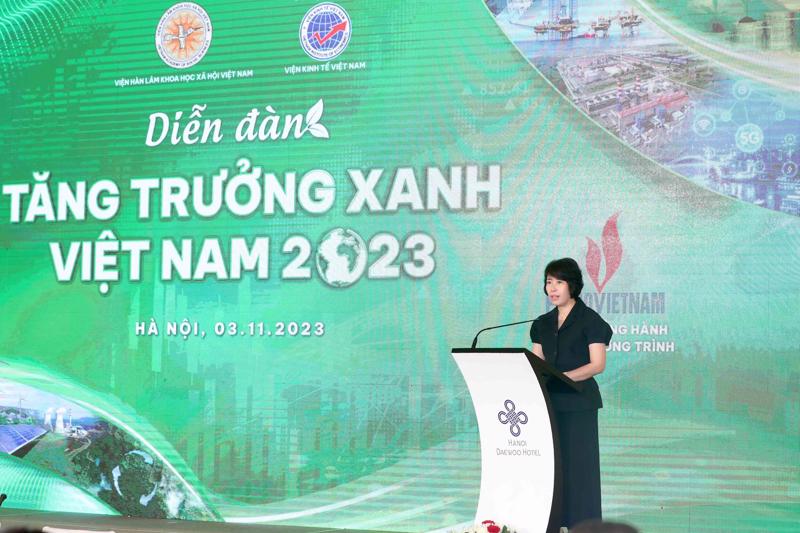Financial sources limited for green growth
Vietnam Green Growth Forum hears from experts about mobilizing the capital needed for Vietnam to reach its green goals.

Financial resources mobilized to implement the national strategy on climate change and green growth are still low compared to actual needs, Deputy Minister of Planning and Investment Nguyen Thi Bich Ngoc told the Vietnam Green Growth Forum 2023 in Hanoi on November 3.
She said resources to implement green growth goals are limited, especially in the context of constrained State budget resources and many regional and global problems in need of a response.
According to calculations from the Ministry of Planning and Investment, Vietnam requires nearly $60 billion to implement the target program on climate change and green growth in the 2016-2021 period.
The medium-term public investment plan can meet only $26 billion, and the remainder must be mobilized from the business sector. Closing the gap between investment needs and actual financial flows creates a need for improved mechanisms and policies to attract investment from State-owned and private enterprises, the latter of which are considered to have not yet fully exploited their potential.
Deputy Minister Ngoc said that in implementing the green growth strategy, resources mobilization and equitable energy transition are fundamental solutions to help Vietnam address the challenges of climate change and the urgent need to cut greenhouse gases while still ensuring sustainable economic growth.
According to Associate Professor Bui Quang Tuan, the green credit market has been promoted over recent years through policies and support measures from the State Bank of Vietnam, such as support for improving financial capacity at credit institutions to implement green credit through negotiating and signing programs, while it also issued a manual on assessing environmental and social risks in granting credit to ten economic sectors, which then had another five added.
However, according to Dr. Ha Huy Ngoc from the Vietnam Institute of Economics (VIE), credit remains small compared to the total credit available in the entire system. “Green credit is mainly focused on green agriculture, which accounts for about 46 per cent, followed by sustainable water management, at about 13 per cent, and recently there has been a trend to shift to other fields such as renewable energy and clean energy,” he noted.
Exchanging international experience on mobilizing capital for green growth through the financial market, Mr. Tran Dinh Nuoi from the VIE said doing so through the financial market for green growth has been successful in some developed countries such as the UK, Germany, and South Korea, through financial products such as green bonds or green credit programs from the banking system. Meanwhile, other countries with developing financial backgrounds are also looking for ways to bring these green financial tools into the financial market.
“Vietnam can research and issue green bonds to the world financial market,” he added. “However, it is necessary to carefully study the standards and guidelines for green bond issuance and organize environmental consulting, ratings, and assessments in world market to ensure the success of the issuance.”
The World Bank estimates that the total additional financial needs for Vietnam to implement the roadmap to reduce carbon emissions and improve resilience could reach about $701 billion in the 2022-2040 period, equivalent to 6.8 per cent of GDP each year.
By the end of last June, Vietnam’s green credit had reached VND528 trillion ($22.9 billion), with the proportion of total outstanding debt being 4.2 per cent, an increase of more than 5 per cent compared to the end of 2022.
Dr. Nguyen Thanh Hai, an Economist with the German Agency for International Cooperation (GIZ) in Vietnam, said that, in the long term, to successfully develop a green capital market in Vietnam, supportive solutions are needed to standardize the evaluation criteria and create demand for green financial products.
“It is also necessary to further develop the formation and participation of collective investment funds through the development of tax mechanisms, and encourage investment in the stock market through investment funds, in accordance with international practices,” Mr. Hai said.
Deputy Minister Ngoc said Vietnam has recorded important achievements in socio-economic development and innovation to date but it remains in a modest position in terms of per capita income as well as technological transformation compared to other countries in the region and the world. Achieving green growth goals will therefore bring major long-term benefits.
The government, the Prime Minister, and ministries and branches have recently made great efforts in planning policies and promoting the economy towards green growth, such as promulgating the National Strategy on Green Growth and the Action Plan on its implementation, building a legal framework to create conditions and encourage preferential mechanisms, and approving important plans and promoting digital transformation.
“These results are just the beginning, and there are still many opportunities and challenges ahead,” the Deputy Minister emphasized. “The most prominent point of the green growth strategy is to balance and harmonize greenhouse gas emissions reduction goals with socio-economic development goals. This will be an important solution to promote the process of economic transformation associated with transforming the growth model, improving the competitiveness of the economy and its businesses, and especially bolstering the capacity to withstand external shocks.”



















